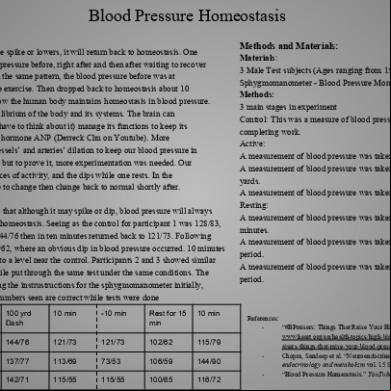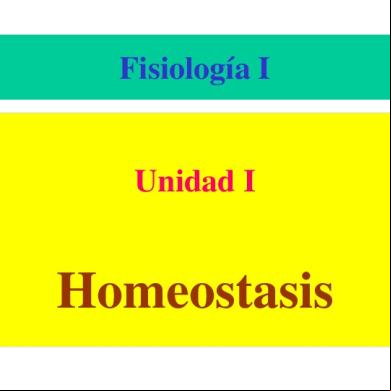Homeostasis Poster 5n5z1q
This document was ed by and they confirmed that they have the permission to share it. If you are author or own the copyright of this book, please report to us by using this report form. Report 2z6p3t
Overview 5o1f4z
& View Homeostasis Poster as PDF for free.
More details 6z3438
- Words: 526
- Pages: 1
Blood Pressure Homeostasis Abstract: When the human body’s blood pressure spike or lowers, it will return back to homeostasis. One way to test this is by measuring blood pressure before, right after and then after waiting to recover from exercise. The results all followed the same pattern, the blood pressure before was at homeostasis and it increased due to the exercise. Then dropped back to homeostasis about 10 minutes after exercising.This shows how the human body maintains homeostasis in blood pressure. Introduction: Homeostasis is the equilibrium of the body and its systems. The brain can involuntarily (meaning that you don’t have to think about it) manage its functions to keep its systems and functions stable using the hormone ANP (Derreck Chu on Youtube). More specifically, it can control the blood vessels’ and arteries’ dilation to keep our blood pressure in check. It is known that this takes place but to prove it, more experimentation was needed. Our experiments capture everyday life, spikes of activity, and the dips while one rests. In the experiments, we expect blood pressure to change then change back to normal shortly after. Discussion/Conclusion: The research confirmed the hypothesis that although it may spike or dip, blood pressure will always return to a safe and stable level due to homeostasis. Seeing as the control for participant 1 was 128/83, the measure while running spiked to 144/76 then in ten minutes returned back to 121/73. Following this, the resting measurement was 102/62, where an obvious dip in blood pressure occurred. 10 minutes later and the blood pressure rose back to a level near the control. Participants 2 and 3 showed similar patterns of blood pressure readings while put through the same test under the same conditions. The tests went well aside from not following the instrustructions for the sphygmomanometer initially, which caused tests to be redone. The numbers seen are correct while tests were done Participant
Control
-10 min
100 yrd Dash
10 min
-10 min
Rest for 15 min
10 min
1
128/83
128/83
144/76
121/73
121/73
102/62
115/79
2
115/71
115/71
137/77
113/69
73/53
106/59
144/90
3
129/69
129/69
142/71
115/55
115/55
100/65
116/72
Methods and Materials: Materials: 3 Male Test subjects (Ages ranging from 15-16) Sphygmomanometer - Blood Pressure Monitor Methods: 3 main stages in experiment Control: This was a measure of blood pressure while going through a typical day and completing work. Active: A measurement of blood pressure was taken 10 minutes prior to running 100 yards. A measurement of blood pressure was taken following shortly after running 100 yards. A measurement of blood pressure was taken 10 minutes after running 100 yards Resting: A measurement of blood pressure was taken 10 minutes prior to resting for 15 minutes. A measurement of blood pressure was taken shortly after the 15 minute resting period. A measurement of blood pressure was taken shortly after the 15 minute resting period.
References: “#BPraisers: Things That Raise Your Blood Pressure.” About Heart Attacks, www.heart.org/en/health-topics/high-blood-pressure/the-facts-about-high-blood-pressure/bpr aisers-things-that-raise-your-blood-pressure. Chopra, Sandeep et al. “Neuroendocrine regulation of blood pressure” Indian journal of endocrinology and metabolism vol. 15 Suppl 4,Suppl4 (2011): S281-8. “Blood Pressure Homeostasis.” YouTube, YouTube, 18 Dec. 2016, youtu.be/j6VzjaOwg0g.
Control
-10 min
100 yrd Dash
10 min
-10 min
Rest for 15 min
10 min
1
128/83
128/83
144/76
121/73
121/73
102/62
115/79
2
115/71
115/71
137/77
113/69
73/53
106/59
144/90
3
129/69
129/69
142/71
115/55
115/55
100/65
116/72
Methods and Materials: Materials: 3 Male Test subjects (Ages ranging from 15-16) Sphygmomanometer - Blood Pressure Monitor Methods: 3 main stages in experiment Control: This was a measure of blood pressure while going through a typical day and completing work. Active: A measurement of blood pressure was taken 10 minutes prior to running 100 yards. A measurement of blood pressure was taken following shortly after running 100 yards. A measurement of blood pressure was taken 10 minutes after running 100 yards Resting: A measurement of blood pressure was taken 10 minutes prior to resting for 15 minutes. A measurement of blood pressure was taken shortly after the 15 minute resting period. A measurement of blood pressure was taken shortly after the 15 minute resting period.
References: “#BPraisers: Things That Raise Your Blood Pressure.” About Heart Attacks, www.heart.org/en/health-topics/high-blood-pressure/the-facts-about-high-blood-pressure/bpr aisers-things-that-raise-your-blood-pressure. Chopra, Sandeep et al. “Neuroendocrine regulation of blood pressure” Indian journal of endocrinology and metabolism vol. 15 Suppl 4,Suppl4 (2011): S281-8. “Blood Pressure Homeostasis.” YouTube, YouTube, 18 Dec. 2016, youtu.be/j6VzjaOwg0g.





